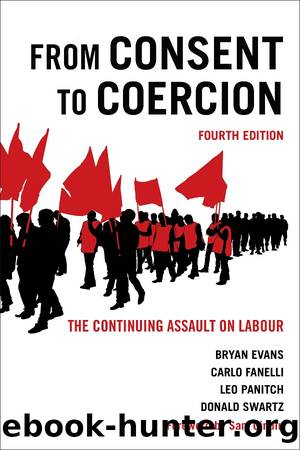From Consent to Coercion by Bryan Evans;Carlo Fanelli;Leo Panitch;Donald Swartz; & Carlo Fanelli & Leo Panitch & Donald Swartz

Author:Bryan Evans;Carlo Fanelli;Leo Panitch;Donald Swartz; & Carlo Fanelli & Leo Panitch & Donald Swartz
Language: eng
Format: epub
Tags: Labor unions – Canada – History, Labor unions – Law and legislation – Canada – History, Collective bargaining – Canada – History
Publisher: University of Toronto Press
Atlantic Canada: Embedded Austerity
The period 2013 to 2020 saw deficits return to each Atlantic province, but the root cause for the erosion of fiscal health varied. In Newfoundland, it was the decline in oil royalties. In Nova Scotia, it was the result of long-standing structural and demographic problems stemming back to the deindustrialization of the 1970s. For New Brunswick, it was a function of a province that has been locked into a trajectory of decline for far too long. And PEI, with the help of federal transfers and a large public sector, was able to muddle through without need of forcing major battles with its public-sector workers. Each province had a somewhat different strategy to deal with this new but familiar fiscal reality. However, the differences were a matter of how intensely the public sector, and those working to deliver public services, would be attacked to return to fiscal balance.
In Nova Scotia, a new Liberal government took the most aggressive approach of the four Atlantic provinces, with the elimination of the deficit within three years as the chief priority. Their argument was that âbudgetary deficits hamper the provinceâs growth prospectsâ and so the 2015 budget stated the government would âhold the line on spending, restructure and reduce the size of government, and continue to clear the way for private sector growth.â63 However, the magnitude of the deficit problem was exaggerated when placed in historical and jurisdictional context. Regardless, the end result was shrinking of the size of the core public service as jobs were cut and public-sector wage restraint implemented. By 2016, budgets had returned to a surplus, lasting through to 2020. These surpluses were accompanied by increases in public expenditure from 2017 forward after the three previous years of restraint. In 2017, overall program spending increased by 4.3 percent but certain priority areas were allocated funds well beyond this level. For example, business development increased by 49 percent and early childhood development by 10 percent. Health care was held to below the average, at 3 percent. The subsequent 2018 budget restricted overall increases in expenditures to 1.8 percent but education and health care were given particular priority; these spending envelopes were increased by 5.5 and 2.4 percent, respectively. The prioritization of health care continued into 2019, where that yearâs budget allocated an additional 4.3 percent to that envelope, above overall program increases of 3.1 percent. In 2020 spending on health care slowed to 2.3 percent but education increased by 3.4 percent.64 In sum, while these years marked a break with the previous period of austerity, the overall increases in expenditures to finance public services was modest.
Given that Nova Scotiaâs public sector was, as in other Atlantic provinces, comparatively large, composing 28 percent of the total workforce and 70 percent of those unionized, a policy regime of that type would be difficult to sustain politically. This, combined with the provinceâs reliance on federal transfers for fiscal sustainability, has meant for Nova Scotia a history of âfiscal experimentationâ and, for the most part, the dominance of government controls on public-sector wages since the early 1990s.
Download
This site does not store any files on its server. We only index and link to content provided by other sites. Please contact the content providers to delete copyright contents if any and email us, we'll remove relevant links or contents immediately.
Zero to IPO: Over $1 Trillion of Actionable Advice from the World's Most Successful Entrepreneurs by Frederic Kerrest(4132)
Machine Learning at Scale with H2O by Gregory Keys | David Whiting(3808)
Harry Potter and the Goblet Of Fire by J.K. Rowling(3668)
Never by Ken Follett(3627)
Ogilvy on Advertising by David Ogilvy(3414)
Shadow of Night by Deborah Harkness(3218)
The Man Who Died Twice by Richard Osman(2887)
Book of Life by Deborah Harkness(2790)
My Brilliant Friend by Elena Ferrante(2719)
0041152001443424520 .pdf by Unknown(2686)
Will by Will Smith(2669)
How Proust Can Change Your Life by Alain De Botton(2658)
The Tipping Point by Malcolm Gladwell(2584)
Purple Hibiscus by Chimamanda Ngozi Adichie(2533)
How to Pay Zero Taxes, 2018 by Jeff A. Schnepper(2532)
Hooked: A Dark, Contemporary Romance (Never After Series) by Emily McIntire(2440)
Rationality by Steven Pinker(2193)
Borders by unknow(2129)
Daughter of Smoke and Bone by Laini Taylor(2096)
